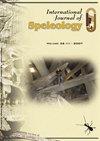开放管道洞穴中中等洪水的经验粗糙度系数:富勒斯河峡谷,卡尔弗森溪洞穴系统,西弗吉尼亚州
IF 1.3
4区 地球科学
Q3 GEOSCIENCES, MULTIDISCIPLINARY
引用次数: 0
摘要
洞流洪水的明渠模型可以提供关于水流速度和剪应力的有用信息,这些信息反过来可以用来估计沉积物的输送能力。所有这些计算都需要粗糙度系数来估计能量损失,并需要先验的流量或流动深度知识来设置模型边界条件。然而,由于观测洞内洪水的困难,通常无法测量流量;粗糙度系数必须根据通道的性质来假设。为了克服这些挑战,我们使用压力传感器监测了西弗吉尼亚州Greenbrier县Fullers洞穴的水流深度,并同时测量了洞穴上游喀斯特窗口的水位和流量。5个压力传感器沿着一个93米长的通道,在一个10米高、平均1.5到3米宽的峡谷中部署。利用电磁流量计对峰值流量小于等于1.66 m3 s-1的洪水确定喀斯特窗口的级流量关系。收集的数据用于获得经验曼宁n粗糙度值,水头损失和能量梯度。计算出的洪水流速与从通道壁上的扇贝获得的数值相当。在击穿部分阻塞通道的地方观察到主要的能量损失。在峰值流量时,卵石底峡谷河段的Manning n平均值为0.053,而破碎河段的Manning n平均值为0.069。粗糙度值随着流量的增加呈指数下降,但使用水头损失计算的摩擦斜率与流量的关系更为复杂。值得注意的是,使用床层梯度计算的n值与使用测量水头损失计算的n值相差只有12%,因此在粗糙度估计中使用床层梯度通常会产生合理的流动条件近似值。富勒斯洞穴经历的明渠洪水比我们观察到的要大得多,因此需要额外的工作来估计更高流量的粗糙度系数。我们的经验粗糙度系数可以应用于其他洞穴和环境中的类似洞穴通道,包括模拟槽状峡谷通道,我们的方法展示了一种测量难以获得数据的技术。开放管道管道数据的增加大大扩展了可以使用经验数据在充满管道的洞穴之外进行建模的环境范围。应用包括研究洪水、沉积物运输和基岩侵蚀过程。所有这些话题都将在未来的富勒斯中讨论。本文章由计算机程序翻译,如有差异,请以英文原文为准。
Empirical roughness coefficients for moderate floods in an open conduit cave: Fullers stream canyon, Culverson Creek Cave System, West Virginia
Open conduit modeling of cave stream floods can yield useful information about water velocities and shear stresses, which can in turn be used to estimate sediment transport capabilities. All such calculations require roughness coefficients for estimating energy losses and a priori knowledge of either discharge or flow depths to set model boundary conditions. However, the difficulties associated with observing in-cave floods generally preclude measuring discharge; roughness coefficients must be assumed based on channel properties. To overcome these challenges, we monitored stream flow depths in Fullers Cave, Greenbrier County, West Virginia using pressure transducers, and simultaneously measured stage and discharge in a karst window immediately upstream of the cave. Five pressure transducers were deployed opportunistically along a 93-meter-long reach in a 10+ meter high canyon averaging 1.5 to 3 meters wide. Stage-discharge relationships were determined for the karst window using an electromagnetic flow meter for floods with peak discharges of 1.66 m3 s-1 or less. The collected data was used to obtain the empirical Manning’s n roughness values, head losses, and energy gradients. Calculated floodwater velocities are comparable to values obtained from scallops on passage walls. Major energy losses were observed where breakdown partially occludes the passage. At peak flow, Manning n values average 0.053 for reaches typified as cobble-floored canyons, but n was 0.069 in the breakdown reach. Roughness values declined exponentially with increasing discharge, but friction slopes calculated using head losses show more complex relationships with discharge. Notably, n values back calculated using bed gradients differ from those calculated using measured head losses by as little as 12%, so the use of bed gradients in roughness estimations will generally yield reasonable approximations of flow conditions. Fullers Cave experiences significantly larger open conduit floods than we observed, so additional work is needed to estimate roughness coefficients for higher discharges. Our empirical roughness coefficients can be applied to similar cave passages in other caves and contexts, including modeling slot canyon-like channels, and our methods demonstrate a technique for measuring hard to obtain data. The addition of data for open conduit conduits significantly expands the range of environments that can be modeled using empirical data beyond pipe-full caves. Applications include studying flooding, sediment transport, and bedrock erosion process. All of these topics will be addressed in Fullers in the future.
求助全文
通过发布文献求助,成功后即可免费获取论文全文。
去求助
来源期刊

International Journal of Speleology
地学-地球科学综合
CiteScore
3.10
自引率
23.10%
发文量
12
审稿时长
>12 weeks
期刊介绍:
The International Journal of Speleology has the aim to get cave and karst science known to an increasing number of scientists and scholars. The journal therefore offers the opportunity to all scientists working in and on karst to publish their original research articles or their review papers in an open access, high quality peer reviewed scientific journal at no cost. The journal offers the authors online first, open access, a free PDF of their article, and a wide range of abstracting and indexing services.
 求助内容:
求助内容: 应助结果提醒方式:
应助结果提醒方式:


